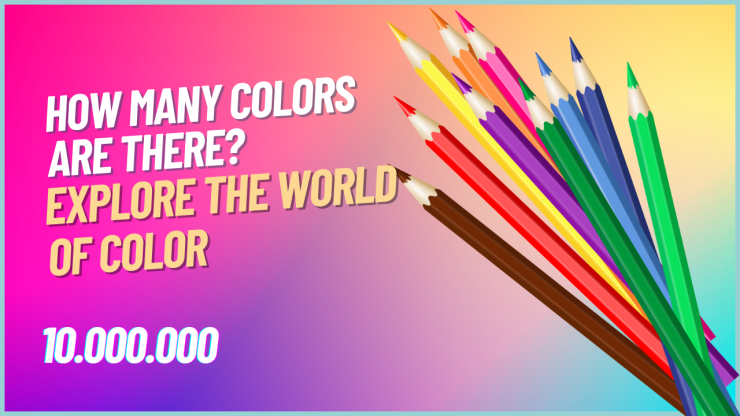Table of Contents
The world of color is fascinating and complex. From the colors of the rainbow to the shades of light, there are millions of colors that the human eye can perceive. However, our color perception and vision deficiencies limit the number of colors we can see. This article will explore the different levels of red, green, blue, and yellow, the primary colors, the color wheel, and more. So, how many variants are there? Let’s find out.
The Number of Colors We Can See
The human eye is an amazing organ that can perceive various colors. However, the number of tones we can see is limited by the number of cones in our eyes. Cones are the cells in the retina that are responsible for color perception. There are three types of cones, each responding to a different range of colors: red, green, and blue. These three cones work together to create the millions of variants we can see.
Scientists say the human eye can distinguish between approximately 10 million variants. However, this number is not exact and can vary depending on a person’s color perception and vision deficiencies.
Colors of the Rainbow

The colors of the rainbow are a familiar sight to most people. The rainbow has seven tones:
- Red
- Orange
- Yellow
- Green
- Blue
- Indigo
- Violet
These variants are created by the dispersion of light, which separates the different wavelengths of light. Rainbow colors are often used as a visual aid to teaching children about colors and light.
Primary Colors
The primary colors are the building blocks of all other variants. There are three primary colors: red, blue, and yellow. These tones cannot be created by mixing different them. Instead, they are used to create all other variants. For example, combining red and blue creates purple, blue and yellow create green, and red and yellow create orange.
Levels of Red, Green, Blue, and Yellow
The levels of red, green, blue, and yellow refer to the intensity of these colors. In digital imaging, the red, green, and blue levels are measured on a scale of 0-255. The higher the level, the brighter and more intense the color. The red, green, and blue levels can be adjusted to create different shades of these tones.
Similarly, the levels of yellow refer to the brightness of this color. The brilliance of yellow can be adjusted to create different shades of this color. In the world of color, the levels of red, green, blue, and yellow are important tools for creating different colors and shades.
Color Wheel

The color wheel is a visual representation of the primary, secondary, and tertiary colors. It is often used as a tool for artists and designers to create color schemes. The color wheel consists of 12 colors: the three primary colors (red, blue, and yellow), the three secondary colors (orange, green, and purple), and the six tertiary colors (red-orange, yellow-orange, yellow-green, blue-green, blue-purple, and red-purple).
Shades of Light
Shades of light refer to the different intensities of light. In digital imaging, the shades of light are measured on a scale of 0-255. The higher the level, the brighter the light. Shades of light are important for creating different moods and atmospheres in photography and cinematography.
Vision Deficiencies
Vision deficiencies are conditions that affect a person’s ability to see certain colors. The most common type of vision deficiency is color blindness, which affects approximately 8% of men and 0.5% of women of Northern European descent. Color blindness is a genetic condition that results in the inability to distinguish between certain colors, particularly red and green.
Other types of vision deficiencies can affect color perception, such as achromatopsia, which is the inability to see any colors, and monochromatism, which is the ability to see only one color.
Color Mixer Tools
There are many online color mixer tools available that allow you to mix and match colors to create your unique color palettes. Some popular tools:
These color mixer tools are great for graphic designers, web designers, and artists who need to create color palettes that work well together. You can experiment with different combinations of colors and see how they look before using them in your project.
Whether creating a website, designing a logo or painting a picture, a color mixer tool can help you make the perfect color scheme for your project.
The World of Color
The world of color is vast and fascinating. Many variants exist to explore and appreciate, from the colors of the rainbow to the shades of light. Colors can evoke emotions, create moods, and communicate ideas.
In addition to their aesthetic value, colors also have practical applications in various industries. For example, they create different styles and trends in the fashion industry. In marketing, they create branding and advertising campaigns that appeal to consumers.
So, how many colors are there? The answer is complex. Our color perception and vision deficiencies limit the number of tones we can see. However, we do know that the human eye can distinguish between approximately 10 million variants and that the combination of red, green, and blue cones in our eyes creates these colors.
From the colors of the rainbow to the shades of light, the world of color is a fascinating and complex subject. Understanding the different levels of red, green, blue, and yellow, the primary colors, and the color wheel can help us appreciate the beauty and complexity of the world around us.










Add comment